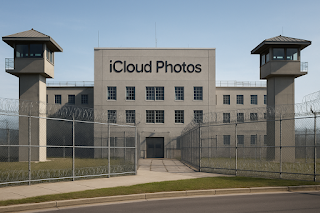Escaping from iCloud Photos

After more than a decade storing photos and videos in iCloud, I decided to download my stuff to my PC and delete the copies at Apple. I figured I'd log into iCloud using my web browser, click the Download link, wait a while for the eighty-plus gigabytes to make their way to my computer, delete the cloud copies, and be done with it.
It didn't work out that way.
What I expected to take a few minutes ended up taking more than a week of screen-staring, head-scratching, teeth-gnashing research, installation of a couple of new apps, and a bunch of manual work that I didn't know how to avoid until most of it was already done.
A good place to start the story is the term "my stuff." I had photos and videos at iCloud, which I'd organized into a few albums, and that's what I wanted to download: photos, videos, and albums. For now, we'll set aside albums and deal with photos and videos.
iCloud Photos is unambiguous about how many it stores for me:
 That's a total of 23,251 items. However, if I install the iCloud for Windows app and sync my photos, this is what File Explorer shows me:
That's a total of 23,251 items. However, if I install the iCloud for Windows app and sync my photos, this is what File Explorer shows me:
 That's 958 more items than iCloud says exist. Not a good sign. Things got worse when I did the same thing with Cloudly, a program I tried in an attempt to deal with the albums issue I'll address later. Here's what File Explorer has to say about the result of syncing Cloudly with iCloud Photos:
That's 958 more items than iCloud says exist. Not a good sign. Things got worse when I did the same thing with Cloudly, a program I tried in an attempt to deal with the albums issue I'll address later. Here's what File Explorer has to say about the result of syncing Cloudly with iCloud Photos:
 That's 1,717 more items than iCloud reports and 759 more than iCloud for Windows downloaded. How can there be so much trouble simply agreeing on how many photos and videos are to be downloaded?!
That's 1,717 more items than iCloud reports and 759 more than iCloud for Windows downloaded. How can there be so much trouble simply agreeing on how many photos and videos are to be downloaded?!The answer involves a detour into Apple's options for downloading.
Apple Download OptionsIn the web browser interface to iCloud Photos, you can click a simple download icon to get what I'll call the Default download. You can also click on the "..." icon and then on "More Download Options..." to select from three more choices. They are Unmodified Originals, Highest Resolution, and Most Compatible. My simple experiments suggest that the Default and Most Compatible options are the same, so the iCloud web site effectively offers these download choices:
Unmodified Originals.This means exactly what it says. It is probably not the droid you're looking for.
When you take a photo with an Apple device and edit it (e.g., crop it or adjust the colors), Apple saves both the original photo and the result of your edits. The edited photo is what you see in iCloud (and in the Photos app on your device), but the original is still lurking in the background in case you decide you'd like revert to it. The same applies to videos. Using the Unmodified Originals download mode gives you your pictures and videos just as you took them--without any of the edits you applied to make them look better.
Sometimes edits are applied automatically, and you may not realize they've been performed. A good example is photos taken in Portrait Mode. The only image you see on your device is the one with the background blurred, but behind the scenes an ordinary (unblurred) photo is taken and some transformations (i.e., edits) are applied. If you download the Unmodified Original for a Portrait Mode photo, you'll get the truly original one, the one without any blurring.
The iCloud item count doesn't include the original versions of edited photos. However, when Cloudly downloads edited photos, it downloads both the final image and its first forebear. That's one of the reasons Cloudly downloaded so many more items for me than iCloud said it contained.
Most Compatible (the default). Apple says that using this download mode yields JPEG photos and videos that are MP4/H.264, the idea being that these formats are more widely supported (especially on non-Apple systems) than the HEIC photos and H.265 videos Apple devices typically produce. In contrast to Unmodified Originals mode, the files you download include edits you've applied.
What Apple fails to mention is that Most Compatible downloading incurs a significant reduction in resolution in the photos and videos you end up with. In my testing on originals taken on an iPhone SE 2, photos generally went from 3024 x 4032 to 1536 x 2048 (a pixel loss of 74%) and videos from 1920 x 1080 to 1280 x 720 (56%).
I can imagine why Apple made this the default download option. Users would find it frustrating to download something from iCloud and then not be able to view it. However, I think they should be a lot clearer about the implications that has for the quality of the downloaded content.
Highest Resolution. As its name suggests, this download option yields photos and videos with the full resolution available. The versions you download include the edits you've made to them.
If this were the end of the story, I'd download my stuff at Highest Resolution and be done with it. But the story's not finished.
File TimestampsOf the 23,000+ items I have in iCloud Photos, several thousand were sent to me as WhatsApp messages. WhatsApp strips out the internal metadata for, among other things, when a photo or video was taken, so the file itself can't tell me when the item was created. I can approximate it, however, by using the date and time when I got the message. That's enshrined in the creation timestamp of the file that held the photo or video on my device and was subsequently copied into iCloud. That means that when I download something from iCloud onto my PC, I want the creation date and time of the file on my PC to match the creation date and time of the file in iCloud Photos. Otherwise I'd have to review all my old WhatsApp messages to determine that, say, this photo was sent to me on March 13, 2017:

None of the download options above--the ones offered by the web browser interface to iCloud Photos--preserve file creation timestamps. If I download that photo using a web browser today, the file creation timestamp will be for today. Nothing about the picture or the file will tell me that it's from 2017.
For me, that's a deal-killer. Downloading using a web browser is out. (It was already pretty close to out, anyway, because iCloud limits browser-based downloads to 1000 items at a time. Downloading my stuff would have required that I select and download batches of items 23 times. That's doable, but ridiculous.)
Fortunately, Apple has an alternative way to download photos and videos from iCloud to a PC: the iCloud for Windows app. Its design approach is quite different from that in the browser. There no choice in which type of download you want (nor is the type it uses documented, from what I can tell), but my testing suggests that it's the same as Highest Resolution. That's good for me, because it's what I want, but even better is that files downloaded using iCloud for Windows retain the creation timestamps they have in iCloud. That means the photos and videos sent to me in old WhatsApp messages are in files with creation dates and times corresponding to when I received them. That, in turn, will allow me to use exiftool to copy those file-based timestamps into the files' metadata, thus restoring (more or less) the "date taken" information that was originally there and that WhatsApp got rid of.
iCloud for Windows thus solves two-thirds of the problem of getting my stuff from iCloud Photos: the parts for photos and videos. For the final part--albums--iCloud for Windows is sadly and infuriatingly useless.
iCloud has two kinds of albums, shared and unshared. There are important differences between them (which Apple doesn't seem to directly describe anywhere), but for my purposes, both are just collections of photos and videos that are in my photo library. When downloading my stuff, I want to download these collections, too. At the very least, I want to download representations of the albums I have and the photos and videos that are in each of them. Almost as fundamental is the ability to have the downloaded representations retain any custom ordering I've done on each album's contents. That is, if I've arranged the photos and videos in an album to tell a story in a particular way, I want my arrangement to be preserved.
For Windows users, Apple offers no support for any of this. You can do things manually, of course (e.g., create folders in your PC's file system for each of your albums, use the iCloud web interface to download album contents (in 1000-item batches) into the folders, then use software like FastStone Image Viewer to arrange and rename the items so they stay in the order you want them in, etc.), but you're completely on your own. It's dismissive--even insulting--on Apple's part.
If you have a Mac, things are better. There you can use the Photos app to export album contents to the file system. Using the Sequential File Naming option gives the exported items names such that when you list them in alphabetical order, you get them in the order shown in the album. File timestamps are correctly preserved.
The only thing missing is the ability to export all albums at once. You have to manually export them one by one. It's a lot better than the nothing offered Windows users, but it's not perfect. The more albums you have, the further from perfect it is.
I have a Mac, but I preferentially use Windows, so I scoured the web looking for a way to download albums from iCloud. Pickings are slim, but I eventually came upon Cloudly, a program promising to "[preserve the] album structure of your iCloud Photo Library." It's a largely hollow claim. Cloudly downloads only unshared albums (not shared ones), and it doesn't preserve item orderings within the albums. As for the downloads themselves, they're, um, quirky.
For edited photos, Cloudly downloads both the unmodified originals as well as the highest resolution versions. For videos, it downloads unmodified originals only; there is no way to download the revised versions of videos you've edited. On the plus side, file timestamps are properly copied from iCloud.
Shared albums are downloaded as separate copies of the items in your iCloud library following the rules above, so if you have an edited photo in five unshared albums, you'll end up with six downloaded copies of the unmodified original--one for each of the albums plus one for the library as a whole--and six copies of its highest resolution version. (Similar file replication results from the Mac-album-export approach: each exported album contains its own copy of the Highest Resolution version of each item in the album.)
Cloudly's only download option is for an entire iCloud library. For me, Cloudly said when it finished that about 500 items had failed to download. It gave me a "retry" option, which caused it to try to download the missing items again. It got about half of them, thus leaving me about 250 items short of my full library. I clicked "retry" again, and the number of un-downloaded items was reduced again. After about a dozen iterations of this, it finally told me that everything had been downloaded.
My experience with Cloudly made me wish I'd been less reluctant to go the Mac route...
"Downloading My Stuff" RevisitedI can now be more precise about what I mean when I say I want to download my stuff:
I want a copy of all my photos and all my videos in the best available quality. For edited items, I want the most recent version. I want the file creation timestamps to match those in iCloud.I want all my albums (shared and unshared) to have some kind of representation (presumably folders) in what I download. I want the order of the items in my albums to be preserved. I want the downloads to proceed without manual intervention.What I don't want is to have to break my downloads into 1000-item batches or sacrifice file-creation timestamps (as the iCloud web browser interface demands), to have my albums ignored (as iCloud for Windows does), to have to export albums manually (as the Mac Photos app requires), or to have the item orderings in my albums disregarded (as Cloudly does). Pardon me for channeling the feelings of every user of every piece of software everywhere, but really, people, I don't think I'm asking for anything unreasonable!
An iCloud Photos Escape PlanIf you find yourself wanting to get your stuff out of iCloud and on to Windows, this is my suggested approach:
Install iCloud for Windows and let it sync. This gives you high-quality copies of your photos and videos with the correct file timestamps.If you have a Mac, configure its Photos app's iCloud settings to "Download Originals to this Mac", then export the albums one bv one (sigh) into folders named after the albums. Specify sequential file naming for the exporting. Copy the resulting folders to Windows.I'm a little abashed to admit that this is pretty close to what ChatGPT suggested when I asked it how I could get my stuff. In my defense, I also asked Perplexity, Grok, Claude, Gemini and Copilot, and none recommended using a Mac. Copilot even implied that ChatGPT's approach wouldn't work: "The native Photos app on macOS does not preserve album structure when exporting..." At the time I asked these chatbots for advice, I was hoping to stick with a Windows-based solution. I didn't try using a Mac for albums until I'd gone down a bunch of Windows-centric dead ends.
If you don't have a Mac, things are more complicated, but ChatGPT had some suggestions. In an act of contrition for failing to take its advice as seriously as I should have, here's a link to our discussion. My contrition is minimal, however, because, well, read on.
Aside: Chatbots Again Fail as Research AssistantsAll the information above is based on experiments I ran, but when deciding which experiments to perform, I sometimes took the opportunity to test LLM chatbots by asking them questions I needed to answer. Here's one of the questions I posed (in each case to the free version of whichever chatbot I was using):
When downloading photos and videos to a PC from iCloud using a web browser, there are three download options: Unmodified Originals, Highest Resolution, and Most compatible. When downloading using the iCloud for Windows app, there are no download options, the files are just downloaded. Which web browser download option does iCloud for Windows use?
The results were terrible. Grok, Perplexity, Copilot, and Gemini all confidently stated that iCloud for Windows downloads unmodified originals. ChatGPT was equally sure that the answer was Most Compatible, and Copilot agreed (though with less certainty). All of them were wrong. iCloud for Windows uses Highest Resolution. At least it does for me. All that chatbot opposition spurred me to check many, many times.
As I've said before (e.g., here and here), LLM chatbots--or at least the free versions thereof--have a long way to go before they'll be reliable research aids. I continue to look forward to their getting there.
Scott Meyers's Blog
- Scott Meyers's profile
- 118 followers



